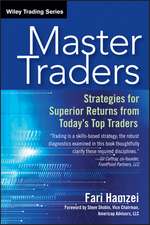Capital Returns: Investing Through the Capital Cycle: A Money Manager’s Reports 2002-15
Editat de Edward Chancelloren Limba Engleză Hardback – 25 noi 2015
Preț: 362.93 lei
Preț vechi: 437.27 lei
-17% Nou
Puncte Express: 544
Preț estimativ în valută:
69.46€ • 72.24$ • 57.34£
69.46€ • 72.24$ • 57.34£
Carte disponibilă
Livrare economică 25 martie-08 aprilie
Livrare express 08-14 martie pentru 31.70 lei
Preluare comenzi: 021 569.72.76
Specificații
ISBN-13: 9781137571649
ISBN-10: 1137571640
Pagini: 211
Ilustrații: XIV, 211 p.
Dimensiuni: 155 x 235 x 19 mm
Greutate: 0.48 kg
Ediția:1st ed. 2015
Editura: Palgrave Macmillan UK
Colecția Palgrave Macmillan
Locul publicării:London, United Kingdom
ISBN-10: 1137571640
Pagini: 211
Ilustrații: XIV, 211 p.
Dimensiuni: 155 x 235 x 19 mm
Greutate: 0.48 kg
Ediția:1st ed. 2015
Editura: Palgrave Macmillan UK
Colecția Palgrave Macmillan
Locul publicării:London, United Kingdom
Cuprins
Contents
List Of Charts And Tables
Foreword
Editor '' ''s Note
Introduction
PART I: INVESTMENT PHILOSOPHY
1. Capital Cycle Revolution
1.1 Evolution Of Cooperation (February 2004)
1.2 Cod Philosophy (August 2004)
1.3 This Time '' ''s No Different (May 2006)
1.4 Supercycle Woes (May 2011)
1.5 No Small Beer (February 2010)
1.6 Oil Peak (February 2012)
1.7 Major Concerns (March 2014)
1.8 A Capital Cycle Revolution (March 2014)
1.9 Growth Paradox (September 2014)
2. Value In Growth
2.1 Warning Labels (September 2002)
2.2 Long Game (March 2003)
2.3 Double Agents (June 2004)
2.4 Digital Moats (August 2007)
2.5 Quality Time (August 2011)
2.6 Escaping The Semis '' '' Cycle (February 2013)
2.7 Research Enabler (March 2013)
2.8 Value In Growth (August 2013)
2.9 Quality Control (May 2014)
2.10 Under The Radar (February 2015)
3. Management Matters
3.1 Food For Thought (September 2003)
3.2 Meet The Management (March 2007)
3.3 Cyclical Misteps (August 2010)
3.4 A Capital Allocator (September 2010)
3.5 Northern Stars (March 2011)
3.6 Say On Pay (February 2012)
3.7 Happy Families (March 2012)
3.8 The Wit And Wisdom Of Johann Rupert (June 2013)
3.9a Meeting Of Minds (June 2014)
3.10 Culture Vulture (February 2015)
PART II - BOOM, BUST, BOOM
4. Accidents-In-Waiting
4.1 Accidents-In-Waiting (2002-08)
4.2 The Builders '' '' Bank (May 2004)
4.3 Insecuritization (November 2002)
4.4 Carry On Private Equity (December 2004)
4.5 Blowing Bubbles (May 2006)
4.6 Pass The Parcel (February 2007)
4.7 Property Fiesta (February 2007)
4.8 Conduit Street (August 2007)
4.9 On The Rocks (September 2007)
4.10 Seven Deadly Sins (November 2009)
5. The Living Dead
5.1 Right To Buy (November 2008)
5.2 Spanish Deconstruction (November 2010)
5.3 Piigs Can Fly (November 2011)
5.4 Broken Banks (September 2012)
5.5 Twilight Zone (November2012)
5.6 Capital Punishment (March 2013)
5.7 Living Dead (November 2013)
5.8 Relax, Mr Piketty (August 2014)
6. China Syndrome
6.1 Oriental Tricks (February 2003)
6.2 Dressed To Impress (November 2003)
6.3 Game Of Loans (March 2005)
6.4 What Lies Beneath (February 2014)
6.5 Value Traps (September 2014)
7. Inside The Mind Of Wall Street
7.1 A Complaint (December 2003)
7.2 Private Party (December 2005)
7.3 Christmas Cheer (December 2008)
7.4 Former Greedspin Boss Flees China (December 2010)
7.5 Occupy Bundestag (December 2011)
7.6 Season '' ''s Greetings (December 2012)
7.7 Lunch With The Gir (December 2013)
7.8 All Change (December 2014)
List Of Charts And Tables
Foreword
Editor '' ''s Note
Introduction
PART I: INVESTMENT PHILOSOPHY
1. Capital Cycle Revolution
1.1 Evolution Of Cooperation (February 2004)
1.2 Cod Philosophy (August 2004)
1.3 This Time '' ''s No Different (May 2006)
1.4 Supercycle Woes (May 2011)
1.5 No Small Beer (February 2010)
1.6 Oil Peak (February 2012)
1.7 Major Concerns (March 2014)
1.8 A Capital Cycle Revolution (March 2014)
1.9 Growth Paradox (September 2014)
2. Value In Growth
2.1 Warning Labels (September 2002)
2.2 Long Game (March 2003)
2.3 Double Agents (June 2004)
2.4 Digital Moats (August 2007)
2.5 Quality Time (August 2011)
2.6 Escaping The Semis '' '' Cycle (February 2013)
2.7 Research Enabler (March 2013)
2.8 Value In Growth (August 2013)
2.9 Quality Control (May 2014)
2.10 Under The Radar (February 2015)
3. Management Matters
3.1 Food For Thought (September 2003)
3.2 Meet The Management (March 2007)
3.3 Cyclical Misteps (August 2010)
3.4 A Capital Allocator (September 2010)
3.5 Northern Stars (March 2011)
3.6 Say On Pay (February 2012)
3.7 Happy Families (March 2012)
3.8 The Wit And Wisdom Of Johann Rupert (June 2013)
3.9a Meeting Of Minds (June 2014)
3.10 Culture Vulture (February 2015)
PART II - BOOM, BUST, BOOM
4. Accidents-In-Waiting
4.1 Accidents-In-Waiting (2002-08)
4.2 The Builders '' '' Bank (May 2004)
4.3 Insecuritization (November 2002)
4.4 Carry On Private Equity (December 2004)
4.5 Blowing Bubbles (May 2006)
4.6 Pass The Parcel (February 2007)
4.7 Property Fiesta (February 2007)
4.8 Conduit Street (August 2007)
4.9 On The Rocks (September 2007)
4.10 Seven Deadly Sins (November 2009)
5. The Living Dead
5.1 Right To Buy (November 2008)
5.2 Spanish Deconstruction (November 2010)
5.3 Piigs Can Fly (November 2011)
5.4 Broken Banks (September 2012)
5.5 Twilight Zone (November2012)
5.6 Capital Punishment (March 2013)
5.7 Living Dead (November 2013)
5.8 Relax, Mr Piketty (August 2014)
6. China Syndrome
6.1 Oriental Tricks (February 2003)
6.2 Dressed To Impress (November 2003)
6.3 Game Of Loans (March 2005)
6.4 What Lies Beneath (February 2014)
6.5 Value Traps (September 2014)
7. Inside The Mind Of Wall Street
7.1 A Complaint (December 2003)
7.2 Private Party (December 2005)
7.3 Christmas Cheer (December 2008)
7.4 Former Greedspin Boss Flees China (December 2010)
7.5 Occupy Bundestag (December 2011)
7.6 Season '' ''s Greetings (December 2012)
7.7 Lunch With The Gir (December 2013)
7.8 All Change (December 2014)
Recenzii
“Capital Returns brings together industrial economics, Michael Porter’s competitive analysis and behavioral finance, into a powerful long-term investment approach that Marathon Asset Management calls ‘capital cycle’ analysis. … This is one of the best investing books I’ve read. Highly recommended!” (Strictly Value, strictlyvalue.wordpress.com, January, 2016)
“First, it covers an important and underappreciated subject, the capital cycle. Second, it contains a superb introduction by one of the great financial writers of our era, Edward Chancellor. … Capital Returns explores an oft-neglected mechanism in the capital markets. It will prove profitable reading for any finance professional, and for the securities analyst, it is essential reading.” (William J. Bernstein, CFA Institute Publications, cfapubs.org, Vol. 11 (1), 2016)
“First, it covers an important and underappreciated subject, the capital cycle. Second, it contains a superb introduction by one of the great financial writers of our era, Edward Chancellor. … Capital Returns explores an oft-neglected mechanism in the capital markets. It will prove profitable reading for any finance professional, and for the securities analyst, it is essential reading.” (William J. Bernstein, CFA Institute Publications, cfapubs.org, Vol. 11 (1), 2016)
Notă biografică
Edward Chancellor (editor and introduction) is the author of Devil Take the Hindmost: A History of Financial Speculation (FSG, 1999), a New York Times 'Notable Book of the Year' and editor of Marathon's previous book, Capital Account: A Money Manager's Reports on a Turbulent Decade (Thomson Texere, 2004). Mr. Chancellor is an award-winning financial journalist, who has written for the Financial Times, Wall Street Journal, Reuters and many other publications. He is a former member of the asset allocation team at GMO, a Boston-based investment firm.
Marathon Asset Management (trading in the United States as Marathon-London) is an independent owner managed investment firm based in London. Founded in 1986, Marathon has successfully applied longer-term and often contrarian investment strategies around the globe.
Marathon Asset Management (trading in the United States as Marathon-London) is an independent owner managed investment firm based in London. Founded in 1986, Marathon has successfully applied longer-term and often contrarian investment strategies around the globe.


























